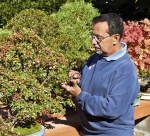Ume, Japanese Apricot
+12
John Quinn
moyogijohn
coh
Pavel Slovák
Randy_Davis
xuan le
Robert Steven
pjkatich
William N. Valavanis
drgonzo
Todd Ellis
Russell Coker
16 posters
Page 1 of 3
Page 1 of 3 • 1, 2, 3 
 Ume, Japanese Apricot
Ume, Japanese Apricot
I bought a pink flowering apricot stick-in-a-pot (3 gallon) about 12 years ago. I never thought much about it as bonsai and figured I'd grow it off as a garden tree. Sadly, it's a western hybrid, so it has the terrible name of P. m. 'Peggy Clark' - no pretty Japanese name for this one. On the bright side, it blooms really well here considering our mild winters. Over the years I've bumped it up, finally to a 10 gallon pot. I got to looking at it and realized it had a great lower trunk and roots under the soil, but the trunk was straight and boring. After exposing about half the root system and removing what I didn't need I planted it in this green pot on its side and it stuck straight out to the left. I figured a portion of the trunk would die, and it did, so I let it regain strength over the last couple of years.
Time to do something with that long staright trunk so I wrapped it with rubber tape, wired it and twisted it back over itself. I like the way it turned out, so I finished wiring the branches and slipped it into this pot by Shuho. This is my stand from the Display Forum.
For a size reference, the rebar is 2 feet long.






That taped area is dead wood, and so is a lot of the trunk going into the soil. You can see the root that used to be at the soil surface. Plenty of carving to do later.
R
Time to do something with that long staright trunk so I wrapped it with rubber tape, wired it and twisted it back over itself. I like the way it turned out, so I finished wiring the branches and slipped it into this pot by Shuho. This is my stand from the Display Forum.
For a size reference, the rebar is 2 feet long.






That taped area is dead wood, and so is a lot of the trunk going into the soil. You can see the root that used to be at the soil surface. Plenty of carving to do later.
R

Russell Coker- Member
 Re: Ume, Japanese Apricot
Re: Ume, Japanese Apricot
Excellent tree, great Idea for the straight trunk, I know Peggy clark is a highly desirable cultivar, even if it does have a dumpy kind of a name.
-Jay
-Jay

drgonzo- Member
 Re: Ume, Japanese Apricot
Re: Ume, Japanese Apricot
Russ, was your tree grafted? Also, those first curves in the trunk were under the soil? Wow!

Todd Ellis- Member
 Re: Ume, Japanese Apricot
Re: Ume, Japanese Apricot
Russell
I've been doing some research on ume for the past few days for my new catalog listing 6 different cultivars. I discovered that Peggy Clark was introduced from Japan in the 1840's and the plant was given a new name. Only problem is that I forgot where I read that information.ill report when I find the original correct Japanese name.
Bill
Just found the source: The species Prunus mime was introduced to the US in the 1840's, NOT Peggy Clark.
Peggy Clark was introduced into the US by plant breeder W.B. Clark in 1941 who named it after one of his three daughters.
Sorry about the incorrect information, but I did find other ume cultivars with English names which were changed from Japanese when thy were introduced from Japan.
I've been doing some research on ume for the past few days for my new catalog listing 6 different cultivars. I discovered that Peggy Clark was introduced from Japan in the 1840's and the plant was given a new name. Only problem is that I forgot where I read that information.ill report when I find the original correct Japanese name.
Bill
Just found the source: The species Prunus mime was introduced to the US in the 1840's, NOT Peggy Clark.
Peggy Clark was introduced into the US by plant breeder W.B. Clark in 1941 who named it after one of his three daughters.
Sorry about the incorrect information, but I did find other ume cultivars with English names which were changed from Japanese when thy were introduced from Japan.
Last edited by William N. Valavanis on Sun Dec 18, 2011 2:18 am; edited 1 time in total (Reason for editing : New information)

William N. Valavanis- Member
 Re: Ume, Japanese Apricot
Re: Ume, Japanese Apricot
Looks good Russell.
That pot will work very nicely with the deadwood once it has been processed.
What are your plans for the tertiary branching?
Regards,
Paul
That pot will work very nicely with the deadwood once it has been processed.
What are your plans for the tertiary branching?
Regards,
Paul

pjkatich- Member
 Re: Ume, Japanese Apricot
Re: Ume, Japanese Apricot
Thanks so much Bill, I'd really appreciate that! I know a lot of camellias got renamed too, 'Pink Perfection' comes to mind. I think that one is actually 'Otome', but don't quote me on that...
Todd, you can see that root in the second picture at the bottom of the pot with the wire tied to it. It's not grafted.
R
Todd, you can see that root in the second picture at the bottom of the pot with the wire tied to it. It's not grafted.
R

Russell Coker- Member
 Re: Ume, Japanese Apricot
Re: Ume, Japanese Apricot
Hey Bill, thanks for the update. I'm sure Peggy is a sweet girl, but I may make up my own Japanese name, a la satsuki - plenty to choose from there!
Paul, I think ume are better as "clip and grow" so this will be work in progress for a long time!
Paul, I think ume are better as "clip and grow" so this will be work in progress for a long time!

Russell Coker- Member
 Re: Ume, Japanese Apricot
Re: Ume, Japanese Apricot
Very nice twisted trunk, do you have some pictures of the tree before the transformation?
Regards
Xuan
Regards
Xuan
xuan le- Member
 Re: Ume, Japanese Apricot
Re: Ume, Japanese Apricot
No Xuan, I don't. As usual I start working and then think about the camera. One of these days I'll remember to take some before pictures.
It stuck straight out to the left with an upward bend. The live vein ran across the top and the underside is deadwood. That's the part thats wrapped now. It was twisted 180 degrees, so the branches are upside down.
R
It stuck straight out to the left with an upward bend. The live vein ran across the top and the underside is deadwood. That's the part thats wrapped now. It was twisted 180 degrees, so the branches are upside down.
R

Russell Coker- Member
 Re: Ume, Japanese Apricot
Re: Ume, Japanese Apricot
William N. Valavanis wrote:
Just found the source: The species Prunus mime was introduced to the US in the 1840's, NOT Peggy Clark.
Peggy Clark was introduced into the US by plant breeder W.B. Clark in 1941 who named it after one of his three daughters.
Sorry about the incorrect information, but I did find other ume cultivars with English names which were changed from Japanese when thy were introduced from Japan.
Bill,
Does your list include P. mume 'verdicalyx'. My brother and I have had this cultivar for a long time and I've never known the origin of it. It came from our old Boss Peter Sugawara in California who collected all kinds of odd things from around the country and Japan. It's very simular to W. B. Clark's 'Rosemary Clark' which is a single white flower with a red calyx but in this case it's a smaller single flower petals with a green calyx and stamens. If you happen to run across any intresting information during your investigation I'd like to hear about it
Russell,
Lovely work bud! that will be a very nice tree indeed once you have finished the foliage! Should be stunning when it's full of those double pink flowers in January!

Randy_Davis- Member
 Re: Ume, Japanese Apricot
Re: Ume, Japanese Apricot
Randy_Davis wrote: Bill,
Does your list include P. mume 'verdicalyx'. My brother and I have had this cultivar for a long time and I've never known the origin of it. It came from our old Boss Peter Sugawara in California who collected all kinds of odd things from around the country and Japan. It's very simular to W. B. Clark's 'Rosemary Clark' which is a single white flower with a red calyx but in this case it's a smaller single flower petals with a green calyx and stamens. If you happen to run across any intresting information during your investigation I'd like to hear about it.
Also, guys, where was W. B. Clark located? My understanding is that 'Peggy Clark' was developed for warmer areas, so maybe his others too? Just curious.
Also, if anyone's looking, a good source is Camellia Forest Nursery...
http://www.camforest.com/Prunus_mume_s/2.htm

Russell Coker- Member
 Re: Ume, Japanese Apricot
Re: Ume, Japanese Apricot
Hi Russell
Very nice tree. Beautiful, elegant movement. I look forward to the flowers. I hope you put up here.
Gretings Pavel
Very nice tree. Beautiful, elegant movement. I look forward to the flowers. I hope you put up here.
Gretings Pavel

Pavel Slovák- Member
 Re: Ume, Japanese Apricot
Re: Ume, Japanese Apricot
Russell Coker wrote:
Also, guys, where was W. B. Clark located? My understanding is that 'Peggy Clark' was developed for warmer areas, so maybe his others too? Just curious.
Also, if anyone's looking, a good source is Camellia Forest Nursery...
http://www.camforest.com/Prunus_mume_s/2.htm
Russell,
W.B. Clark's nursery was located in San Jose, California at the southern End of the San Francisco Bay. Mr. Clark did a lot of hybridizing of both Prunus mume and Chaenomeles (flowering quince). My P. mume 'verdicalyx' could have been from his collection or the collection of Mr. Domoto in Fremont, CA who also had a large collection of camellias and azalea's from Japan along with other intresting things. But with the way that my boss collected it could have come from any number of odd ball sources of old plant collectors.

Randy_Davis- Member
 Re: Ume, Japanese Apricot
Re: Ume, Japanese Apricot
Russell,
I'm curious - how much of the bending/twisting did you do in this latest session? Just the section that is taped/wired, or the entire trunk from the edge of the pot?
Chris
I'm curious - how much of the bending/twisting did you do in this latest session? Just the section that is taped/wired, or the entire trunk from the edge of the pot?
Chris
Last edited by coh on Sun Dec 18, 2011 5:05 pm; edited 1 time in total (Reason for editing : clarification)

coh- Member
 Re: Ume, Japanese Apricot
Re: Ume, Japanese Apricot
Hey Chris, just where it's taped. The other is all natural - dumb luck I guess. Remember that most of that was below the original soil level. When it went from the nursery can into that green pot I was able to lay it on its side.
Thanks for the info Randy, and the nice words Pavel and Robert.
Thanks for the info Randy, and the nice words Pavel and Robert.

Russell Coker- Member
 Re: Ume, Japanese Apricot
Re: Ume, Japanese Apricot
Doing my research on Ume I found an excellent flyer by the JC Raulston Arboretum in North Carolina. Here is a link:
www.ncsu.edu/jcraulstonarboretum/publications/brochures/japanese_flowering_apricots/japanese_flowering_apricots.pdf
Bill
www.ncsu.edu/jcraulstonarboretum/publications/brochures/japanese_flowering_apricots/japanese_flowering_apricots.pdf
Bill

William N. Valavanis- Member
 Re: Ume, Japanese Apricot
Re: Ume, Japanese Apricot
Russell Coker wrote:Hey Chris, just where it's taped. The other is all natural - dumb luck I guess. Remember that most of that was below the original soil level. When it went from the nursery can into that green pot I was able to lay it on its side.
I'll take dumb luck over no luck every time!
Chris

coh- Member
 Re: Ume, Japanese Apricot
Re: Ume, Japanese Apricot
Since we're discussing ume's, I'm going to ask this general question - maybe Bill can comment since he's in the same area as me. I have a small seedling ume (unknown lineage) that I acquired last year. I'd like to plant this in the ground for faster development if possible. Are ume's considered ground hardy in colder climates (in this case, Rochester NY area, zone 6)? I've read conflicting information...many sources say they are ground hardy but the flowers will likely be damaged by late freezes/frosts (but I don't care about that for the trunk development state). Thanks!
Chris
Chris
Last edited by coh on Sun Dec 18, 2011 7:20 pm; edited 1 time in total (Reason for editing : clarification)

coh- Member
 Re: Ume, Japanese Apricot
Re: Ume, Japanese Apricot
Chris,
Japanese flowering apricots are winter hardy in this area in the ground. Did you ever wonder why I don't have any specimens? Oh, I've tried them many times but gave up.
They flower in February and March, even in our frigid climate, even when under winter protection. Many hobbyists, including me, overwinter their bonsai in a garage and they will flower then. Since I don't want to put 12 months of care into a plant which I can't enjoy when in blossom I don't have any in my collection. They are not that attractive when in leaf.
Perhaps I'll try again, the flowers are beautiful as is the sweet spicy fragrance.
Bill
Just took a few photos of my overwintering garage, thought you might like to see how I do it.


Japanese flowering apricots are winter hardy in this area in the ground. Did you ever wonder why I don't have any specimens? Oh, I've tried them many times but gave up.
They flower in February and March, even in our frigid climate, even when under winter protection. Many hobbyists, including me, overwinter their bonsai in a garage and they will flower then. Since I don't want to put 12 months of care into a plant which I can't enjoy when in blossom I don't have any in my collection. They are not that attractive when in leaf.
Perhaps I'll try again, the flowers are beautiful as is the sweet spicy fragrance.
Bill
Just took a few photos of my overwintering garage, thought you might like to see how I do it.



William N. Valavanis- Member
 Re: Ume, Japanese Apricot
Re: Ume, Japanese Apricot
Man talk about 10 lbs of Bonsai in a 5lb bag..I remember being in the garage in september, now look at it totally full of trees..wow
Bill whats that pretty pink flowery looking thing in the square cobalt blue pot right up front/center in the picture?
Sorry to interrupt your post, Coh, but at Russell's request the response to this question has been given its own thread as it was such a stunning tree and there seems to be some interest in the species to merit it as a standalone. You can find it HERE . Thanks (Fiona)
Bill whats that pretty pink flowery looking thing in the square cobalt blue pot right up front/center in the picture?
Sorry to interrupt your post, Coh, but at Russell's request the response to this question has been given its own thread as it was such a stunning tree and there seems to be some interest in the species to merit it as a standalone. You can find it HERE . Thanks (Fiona)

drgonzo- Member
 Re: Ume, Japanese Apricot
Re: Ume, Japanese Apricot
The pink bonsai on the right is a Japanese spindle tree, Euonumus sieboldiana. The red bonsai on the left is a Rock cotoneaster, Cotoneaster horizontals.
Yes, there are a lot of bonsai in the garage, but then there are more in the two large playhouses behind.
Bill
Yes, there are a lot of bonsai in the garage, but then there are more in the two large playhouses behind.
Bill

William N. Valavanis- Member
 Re: Ume, Japanese Apricot
Re: Ume, Japanese Apricot
coh wrote:Since we're discussing ume's, I'm going to ask this general question - maybe Bill can comment since he's in the same area as me. I have a small seedling ume (unknown lineage) that I acquired last year. I'd like to plant this in the ground for faster development if possible. Are ume's considered ground hardy in colder climates (in this case, Rochester NY area, zone 6)? I've read conflicting information...many sources say they are ground hardy but the flowers will likely be damaged by late freezes/frosts (but I don't care about that for the trunk development state). Thanks!
Chris
Chris-
I too have seen them listed as zone hardy for USDA 6 and higher, I'm in USDA 5b and technically I'm just a touch colder even than that where I live and at my elevation. So its interesting to realize the difference just between Rochester and Penn Yan. Down here I wouldn't trust them in the ground and would grow them out in a pot along with all the other crazy things I grow in huge pots that I shouldn't be growing down here.
I've been tempted several times by Prunus Mume, the reason I have yet to bite is due to the huge number of wild pin cherries surrounding my house that get leaf-spot every year and then transfer it to every stone fruit in my orchard. I can barely keep up with spraying and even then I often lose the battle, Stone fruits just always wind up being a problem for me every year because of my local flora.
My Iwai Nishiki is forced to be my 'stand in'
-Jay

drgonzo- Member
 Re: Ume, Japanese Apricot
Re: Ume, Japanese Apricot
Jay, I'm pretty sure that is a euonymus, though Bill would have to tell us the species. I've always admired that plant, the fruits are beautiful. Inspired me to pick up a couple of starter plants (euonymus europea) for development.
Bill, thanks for the info on the ume. My primary overwintering areas are in an attached garage and an unheated mudroom, both places where the fragrance could be appreciated (to some degree, at least). Though I have to say, I've never actually seen/smelled an ume in bloom, just read about it.
Chris
oops, I see Bill posted about the euonymus while I was posting. Jay, it's amazing how much difference our proximity to Lake Ontario (about 10 miles for me) makes to the local climate. Your area is definitely in a colder zone. The average low temp we've experienced here each winter is about -10, though it can get quite a bit lower when conditions are right. That doesn't happen too often.
Bill, thanks for the info on the ume. My primary overwintering areas are in an attached garage and an unheated mudroom, both places where the fragrance could be appreciated (to some degree, at least). Though I have to say, I've never actually seen/smelled an ume in bloom, just read about it.
Chris
oops, I see Bill posted about the euonymus while I was posting. Jay, it's amazing how much difference our proximity to Lake Ontario (about 10 miles for me) makes to the local climate. Your area is definitely in a colder zone. The average low temp we've experienced here each winter is about -10, though it can get quite a bit lower when conditions are right. That doesn't happen too often.

coh- Member
Page 1 of 3 • 1, 2, 3 
 Similar topics
Similar topics» 2 days after Christmas and . . .
» Contorted Japanese Flowering Apricot
» Fungicide soak for Japanese flowering apricot? (Or for any prunus?)
» USA source for hard-to-find Japanese flowering apricot cultivars?
» Flowering apricot photos from last March - (It won't be long now!)
» Contorted Japanese Flowering Apricot
» Fungicide soak for Japanese flowering apricot? (Or for any prunus?)
» USA source for hard-to-find Japanese flowering apricot cultivars?
» Flowering apricot photos from last March - (It won't be long now!)
Page 1 of 3
Permissions in this forum:
You cannot reply to topics in this forum






